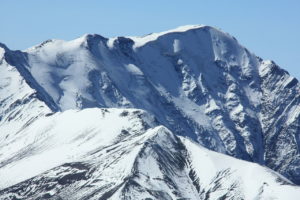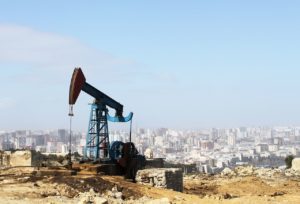Ilham Aliyev, Heydar Aliyev’s son, became chairman of the New Azerbaijan Party as well as President of Azerbaijan when his father died in 2003. He was reelected to a third term as president in October 2013.
Geography:
Geographically, Azerbaijan is located in the South Caucasus region of Eurasia, straddling Western Asia and Eastern Europe.
Three physical features dominate Azerbaijan: the Caspian Sea, whose shoreline forms a natural boundary to the east; the Greater Caucasus mountain range to the north; and the extensive flatlands at the country’s center. There are also three mountain ranges, the Greater and Lesser Caucasus, and the Talysh Mountains, together covering approximately 40% of the country. The highest peak of Azerbaijan is Mount Bazardüzü (4,466 m), while the lowest point lies in the Caspian Sea (−28 m). Nearly half of all the mud volcanoes on Earth are concentrated in Azerbaijan, these volcanoes were also among nominees for the New 7 Wonders of Nature.

The main water sources are surface waters. However, only 24 of the 8,350 rivers are greater than 100 km (62 mi) in length. All the rivers drain into the Caspian Sea in the east of the country. The largest lake is Sarysu (67 km²), and the longest river is Kur (1,515 km), which is trans-boundary with Armenia. Azerbaijan’s four main islands in the Caspian Sea have a combined area of over thirty square kilometers.
Since the independence of Azerbaijan in 1991, the Azerbaijani government has taken measures to preserve the environment of Azerbaijan. National protection of the environment accelerated after 2001 when the state budget increased due to new revenues provided by the Baku-Tbilisi-Ceyhan pipeline. Within four years protected areas doubled and now make up eight percent of the country’s territory. Since 2001 the government has set up seven large reserves and almost doubled the sector of the budget earmarked for environmental protection.
Economy:
Energy:
Two-thirds of Azerbaijan is rich in oil and natural gas. The history of the oil industry of Azerbaijan dates back to the ancient period. Arabian historian and traveler Ahmed Al-Belaruri discussed the economy of the Absheron peninsula in antiquity, mentioning its oil in particular. There are lots of pipelines in Azerbaijan.

The region of the Lesser Caucasus accounts for most of the country’s gold, silver, iron, copper, titanium, chromium, manganese, cobalt, molybdenum, complex ore and antimony. In September 1994, a 30-year contract was signed between the State Oil Company of Azerbaijan Republic (SOCAR) and 13 oil companies, among them Amoco, BP, ExxonMobil, Lukoil and Equinor. As Western oil companies are able to tap deep-water oilfields untouched by the Soviet exploitation, Azerbaijan is considered one of the most important spots in the world for oil exploration and development. Meanwhile, the State Oil Fund of Azerbaijan was established as an extra-budgetary fund to ensure macroeconomic stability, transparency in the management of oil revenue, and safeguarding of resources for future generations.
Agriculture:
Azerbaijan has the largest agricultural basin in the region. About 54.9 percent of Azerbaijan is agricultural land. At the beginning of 2007 there were 4,755,100 hectares of utilized agricultural area. In the same year the total wood resources counted 136 million m³. Azerbaijan’s agricultural scientific research institutes are focused on meadows and pastures, horticulture and subtropical crops, green vegetables, viticulture and wine-making, cotton growing and medicinal plants. In some areas it is profitable to grow grain, potatoes, sugar beets, cotton and tobacco. Livestock, dairy products, and wine and spirits are also important farm products. The Caspian fishing industry concentrates on the dwindling stocks of sturgeon and beluga. In 2002 the Azerbaijani merchant marine had 54 ships.
